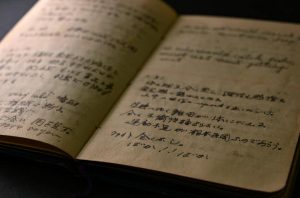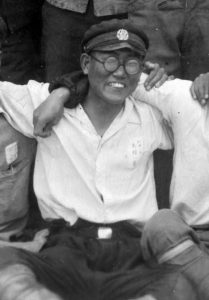Documenting Hiroshima 80 years after A-bombing: On August 9, 1948, with death at 21, journal ends after entry “I’m so tired”
Feb. 6, 2025
by Kyosuke Mizukawa, Senior Staff Writer
On August 9, 1948, Kazuo Kimura, who experienced the atomic bombing in Hiroshima, died at the age of 21. After the bombing, his health had gradually deteriorated, with Mr. Kimura suffering from severe anemia. He studied mechanical engineering at the Hiroshima Technical Institute (present-day Faculty of Engineering, Hiroshima University) in the hopes of becoming a researcher, but he was forced to abandon his dream.
Developed high fever, diarrhea
On August 6, 1945, when a freshman, Mr. Kimura experienced the atomic bombing at a school building in the area of Senda-machi (in Hiroshima’s present-day Naka Ward), located around 2.1 kilometers from the hypocenter. Glass shards pierced his back, and he suffered burns to his left hand. As people were dying one after another of acute effects from radiation, including decreased white blood cell counts and hemorrhaging, he himself suffered from a high fever and diarrhea. To keep his spirits up, he kept a journal. In a journal entry dated September 1, he wrote, “I can’t die. If I died, who would support my aging mother and father?”
Mr. Kimura’s younger sister, Mikiyo, 13 at the time, who had been a first-year student at Hiroshima Prefectural First Girls’ High School (present-day Minami High School), was already dead. She had traveled from their home in what is now Hatsukaichi City to the central area of Hiroshima City to engage in the work of demolishing buildings and was burned over her entire body by the bombing’s thermal rays.
In an entry dated October 15, Mr. Kimura wrote, “Seeing sixth-year girl students running, I shed tears, thinking one might have been Mikiyo.” Two months after the bombing, he wrote about his unbearable feelings after seeing a sports day event at a school near his home. While still holding on to great sorrow, he returned to the Hiroshima Technical Institute, which had resumed classes.
In the spring of 1946, as the new school year began, he read biographies of scientists, which further fueled his desire to study. He wrote, “The greatness of ‘Madame Curie.’ The greatness of ‘Hideyo Noguchi.’ I have to do my best.” Mr. Kimura is said to have had many friends and a strong interest in literature.
However, on April 17, 1946, he wrote in his journal, “As recovery moves along, the disaster is fading from people’s minds. I wonder from where in space the students who died, including Mikiyo, are watching us. The tragedy of those innocent boys and girls is fading with time.” Even amid the gradual increase in buildings amid the incinerated ruins, he continued to think about the many who had died, including Mikiyo.
“Idiot! Idiot”
Mr. Kimura had aimed at attending university, but his health gradually worsened. On January 20, 1948, he wrote in his journal, “My body grows gradually weaker.” The following day, he noted, “I’m not making any progress in my studies. I have a stomachache.” Ultimately, he blamed himself. On January 31, he wrote, “The crowds on the way to school are taking a toll on me. It’s extremely unpleasant. The main cause is probably a lack of exercise. I have no grit. Idiot! Idiot.”
He wrote in an entry on April 23, “I’m so tired all day long.” A few days later, the journal ended. According to the late Taeko Matsuno, Mr. Kimura’s younger sister who spoke in an interview with the Chugoku Shimbun in 2015, a physician had informed him that he only had a short time remaining, to which, Ms. Matsuno explained, “He said repeatedly, ‘I don’t want to die.’”
The cause of his death was diagnosed as ‘severe tuberculosis.’ At the time, the aftereffects of exposure to A-bomb radiation, such as leukemia and increased cancers, were not as well understood as they are today. However, Ms. Matsuno said in her interview, “My brother believed his poor health was due to the effects of the atomic bombing.”
August 9, the day Mr. Kimura died, was precisely three years after the U.S. military dropped an atomic bomb on Nagasaki. On that day, the city held its first culture festival (now known as the Nagasaki Peace Memorial Ceremony), where a peace declaration read by a citizen representative called on people to “Strongly advocate for ‘No More Nagasakis’ and share the message throughout the world.” In Nagasaki, like in Hiroshima, countless lives had been lost, with physical and psychological suffering of A-bomb survivors continuing.
(Originally published on February 6, 2025)
On August 9, 1948, Kazuo Kimura, who experienced the atomic bombing in Hiroshima, died at the age of 21. After the bombing, his health had gradually deteriorated, with Mr. Kimura suffering from severe anemia. He studied mechanical engineering at the Hiroshima Technical Institute (present-day Faculty of Engineering, Hiroshima University) in the hopes of becoming a researcher, but he was forced to abandon his dream.
Developed high fever, diarrhea
On August 6, 1945, when a freshman, Mr. Kimura experienced the atomic bombing at a school building in the area of Senda-machi (in Hiroshima’s present-day Naka Ward), located around 2.1 kilometers from the hypocenter. Glass shards pierced his back, and he suffered burns to his left hand. As people were dying one after another of acute effects from radiation, including decreased white blood cell counts and hemorrhaging, he himself suffered from a high fever and diarrhea. To keep his spirits up, he kept a journal. In a journal entry dated September 1, he wrote, “I can’t die. If I died, who would support my aging mother and father?”
Mr. Kimura’s younger sister, Mikiyo, 13 at the time, who had been a first-year student at Hiroshima Prefectural First Girls’ High School (present-day Minami High School), was already dead. She had traveled from their home in what is now Hatsukaichi City to the central area of Hiroshima City to engage in the work of demolishing buildings and was burned over her entire body by the bombing’s thermal rays.
In an entry dated October 15, Mr. Kimura wrote, “Seeing sixth-year girl students running, I shed tears, thinking one might have been Mikiyo.” Two months after the bombing, he wrote about his unbearable feelings after seeing a sports day event at a school near his home. While still holding on to great sorrow, he returned to the Hiroshima Technical Institute, which had resumed classes.
In the spring of 1946, as the new school year began, he read biographies of scientists, which further fueled his desire to study. He wrote, “The greatness of ‘Madame Curie.’ The greatness of ‘Hideyo Noguchi.’ I have to do my best.” Mr. Kimura is said to have had many friends and a strong interest in literature.
However, on April 17, 1946, he wrote in his journal, “As recovery moves along, the disaster is fading from people’s minds. I wonder from where in space the students who died, including Mikiyo, are watching us. The tragedy of those innocent boys and girls is fading with time.” Even amid the gradual increase in buildings amid the incinerated ruins, he continued to think about the many who had died, including Mikiyo.
“Idiot! Idiot”
Mr. Kimura had aimed at attending university, but his health gradually worsened. On January 20, 1948, he wrote in his journal, “My body grows gradually weaker.” The following day, he noted, “I’m not making any progress in my studies. I have a stomachache.” Ultimately, he blamed himself. On January 31, he wrote, “The crowds on the way to school are taking a toll on me. It’s extremely unpleasant. The main cause is probably a lack of exercise. I have no grit. Idiot! Idiot.”
He wrote in an entry on April 23, “I’m so tired all day long.” A few days later, the journal ended. According to the late Taeko Matsuno, Mr. Kimura’s younger sister who spoke in an interview with the Chugoku Shimbun in 2015, a physician had informed him that he only had a short time remaining, to which, Ms. Matsuno explained, “He said repeatedly, ‘I don’t want to die.’”
The cause of his death was diagnosed as ‘severe tuberculosis.’ At the time, the aftereffects of exposure to A-bomb radiation, such as leukemia and increased cancers, were not as well understood as they are today. However, Ms. Matsuno said in her interview, “My brother believed his poor health was due to the effects of the atomic bombing.”
August 9, the day Mr. Kimura died, was precisely three years after the U.S. military dropped an atomic bomb on Nagasaki. On that day, the city held its first culture festival (now known as the Nagasaki Peace Memorial Ceremony), where a peace declaration read by a citizen representative called on people to “Strongly advocate for ‘No More Nagasakis’ and share the message throughout the world.” In Nagasaki, like in Hiroshima, countless lives had been lost, with physical and psychological suffering of A-bomb survivors continuing.
(Originally published on February 6, 2025)









